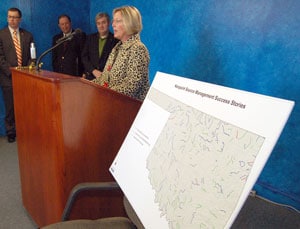Four Oklahoma Streams Removed from EPA 303(d) List
EPA declares water quality work done by Oklahoma agricultural producers and the Oklahoma Conservation Partnership successful; several state streams no longer impaired.

The U.S. Environmental Protection Agency (EPA) has removed four Oklahoma streams from its impaired water or 303(d) list, state conservation leaders announced at a press conference at the Capitol on Feb 2. Efforts by farmers, ranchers and other landowners, in cooperation with the Oklahoma Conservation Partnership to address nonpoint source pollution through voluntary, locally-led means has resulted in the streams being removed from a federal list of impaired water bodies and in even more streams never going on this list, they said. The Oklahoma Association of Conservation Districts (OACD)held the news conference with speakers from state and federal agencies and one farm organization.
EPA administers a list of impaired streams commonly referred to as the 303(d) list. Streams are put on this list when they don’t meet water quality standards, usually because they have too much soil, nutrients or bacteria in the water. Approximately 500 streams statewide are monitored on a rotating basis by the Oklahoma Conservation Commission (OCC). The Oklahoma Conservation Partnership, including the USDA Natural Resources Conservation Service (NRCS), local conservation districts and OCC, then works with farmers, ranchers and other landowners to address these water quality challenges through voluntary, locally-led implementation of best management practices.

Recent monitoring in four of these streams — Wolf Creek in northwest Oklahoma, California Creek in northeast Oklahoma, Little Wewoka Creek in central Oklahoma and Little Elk Creek in southwest Oklahoma— has shown that because of the work done by the landowners in these watersheds, sections of these streams can be removed from the 303(d) list for many of the reasons they were previously listed. In addition, another 170 streams have been shown to meet most of the state’s water quality standards and won’t be listed for these pollutants, due again largely to work done by the agriculture producers and other landowners in these watersheds.
State Secretary of Agriculture Terry Peach and Secretary of Environment J.D. Strong participated in the press conference, as did Oklahoma Farm Bureau President Mike Spradling and NRCS Assistant State Conservationist Gary O’Neill. Vice President Kim Farber and Executive Director Clay Pope represented OACD. Executive Director Mike Thralls and Water Quality Division Director Shanon Phillips represented OCC.

“In most of the streams monitored, conservation efforts and sound management by agriculture producers in these watersheds have preserved a sustainable living environment for fish and a healthy aquatic community,” Phillips said. “The fish and aquatic insects in a stream are an indicator of the health of that stream, but also the landscape that drains to the stream. If the aquatic community is healthy, then the stream is likely to be safe for other uses such as drinking water and agricultural and industrial needs. This happens because agricultural producers have controlled soil erosion, have used pesticides or herbicides wisely and have made sure to not undertake other potentially damaging land use practices. While on some of these streams there may still be individual water quality challenges remaining such as bacteria levels or certain specific nutrient issues, for all intents and purposes the water is clean in these streams and it’s clean because the farmers, ranchers and other landowners who live in these watersheds have worked to keep it that way.”

“This shows what we can do working together — state, federal, local conservation districts and local landowners and producers — to improve natural resource issues in local areas,” Thralls said.
“We are extremely proud of this accomplishment,” Farber said. “When given the chance and the technical and financial help from the state and federal governments, Oklahoma’s agricultural producers and other landowners have answered the call to protect our water.”
“In the past, the government learned that it was best to work cooperatively with landowners to address environmental concerns.” Pope said. “The agricultural producers of our state have shown time and time again that when they are provided financial and technical assistance to address a environmental problem, they will step up to the plate and do what needs to be done, even though it costs them money out of their own pocket. This is how we addressed the Dust Bowl. This recent delisting of streams shows that this approach, when properly funded, will work to address our nonpoint water quality challenges as well.”
